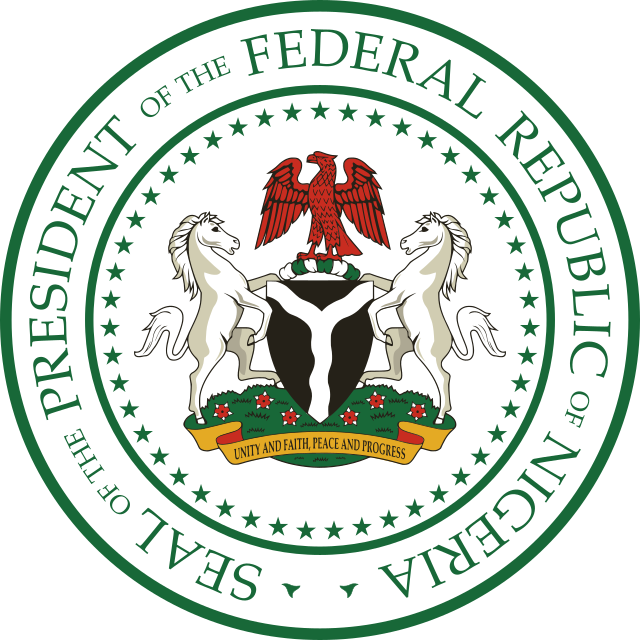Top Qs
Timeline
Chat
Perspective
List of presidents of Nigeria
From Wikipedia, the free encyclopedia
Remove ads
The president of Nigeria is the head of state and head of government of Nigeria, directly elected to a four-year term. Under the Nigerian Constitution, the officeholder leads the executive branch of the federal government and is the commander-in-chief of the Nigerian Armed Forces.[1] After the Independence of Nigeria on 1 October 1960, the first head of state was the queen of Nigeria Elizabeth II, who was also the monarch of other Commonwealth realms; she was represented by a governor-general. Nigeria became a republic under the 1963 constitution and the queen was replaced by a president;[2] Nnamdi Azikiwe, the second governor-general after independence became the first president.[3] Azikiwe shared power with the elected Prime Minister Abubakar Tafawa Balewa.[4] Shehu Shagari was the first elected president of Nigeria.[5] The incumbent president is Bola Tinubu, who assumed office on 29 May 2023.[6][7] Since the office was established in 1963, 14 men have served in 16 presidencies; the discrepancy arises from two individuals who served two non-consecutive terms; as military head of states and as elected presidents: Olusegun Obasanjo and Muhammadu Buhari.[8]


The interim government of Ernest Shonekan, who was deposed 83 days after taking office in 1993, was the shortest in Nigeria's history.[9] Johnson Aguiyi-Ironsi, who served 194 days in office, was the shortest ruled military head of state. Yakubu Gowon served as the longest, for almost nine years, before being deposed in 1975 while he was away from the country.[10] Olusegun Obasanjo served as the longest ruled president, for eleven years, two hundred and thirty days; of his combined two terms.[11]
Four heads of state died in office: two were assassinated during a military coup (Johnson Aguiyi-Ironsi[12] and Murtala Muhammed[13]) and two died of natural causes (Sani Abacha and Umaru Musa Yar'Adua[14]). Five heads of state were deposed in a military coup (Nnamdi Azikiwe, Yakubu Gowon, Shehu Shagari, Muhammadu Buhari and Ernest Shonekan). Obasanjo and Abdulsalami Abubakar resigned after Nigeria's transition to democracy in 1979 and 1999 respectively, while Ibrahim Babangida was forced to resign after he cancelled the 1993 presidential election, which SDP candidate Moshood Abiola reportedly won.[15] Obasanjo was the first vice president (called chief of staff) to become head of state following the 1976 military coup attempt,[16] while Goodluck Jonathan was the first democratically elected vice president to become president after Yar'Adua died on 5 May 2010.[17][18]
Remove ads
First Republic (1963–1966)
The First Republic was the republican government of Nigeria between 1963 and 1966 governed by the first republican constitution. The country's government was based on a federal form of the Westminster system. The period between 1 October 1960, when the country gained its independence and 15 January 1966, when the first military coup d’état took place, is also generally referred to as the First Republic. The first Republic of Nigeria was ruled by different leaders representing their regions as premiers in a federation during this period.
Remove ads
Military Government (1966–1979)
The military dictatorship in Nigeria was a period when members of the Nigerian Armed Forces held power in Nigeria from 1966 to 1999 with an interregnum from 1979 to 1983. The military was able to rise to power often with the tacit support of the elite through coup d'états. Since the country became a republic in 1963, there had been a series of military coups.
Remove ads
Second Republic (1979–1983)
The Second Nigerian Republic was a brief formation of the Nigerian state which succeeded the military governments formed after the overthrow of the first republic.
Military Government (1983–1993)
The military dictatorship in Nigeria was a period when members of the Nigerian Armed Forces held power in Nigeria from 1966 to 1999 with an interregnum from 1979 to 1983. The military was able to rise to power often with the tacit support of the elite through coup d'états. Since the country became a republic in 1963, there had been a series of military coups.
Remove ads
Third Nigerian Republic (1993)
Summarize
Perspective
The Third Republic was the planned republican government of Nigeria in 1992, intended to operate under the Third Republican Constitution.[20] The political framework of the proposed republic included democratically elected state governors, state assemblies, and a National Assembly serving as the federal legislature. However, the system was not fully democratic, as there was no democratically elected President.
The transition programme initiated by then-President Ibrahim Babangida was later perceived as a strategy to retain executive authority while conferring only limited legislative powers on the National Assembly. Under this arrangement, all bills passed by the Senate and the House of Representatives required approval from the National Defence and Security Council before receiving presidential assent.
Although Babangida adopted the title of "President"—a departure from the "Head of State" designation used by earlier military rulers—he repeatedly postponed the conduct of presidential elections. The election eventually held on 12 June 1993 was annulled by his administration.Remove ads
Military Government (1993–1999)
The military dictatorship in Nigeria was a period when members of the Nigerian Armed Forces held power in Nigeria from 1966 to 1999 with an interregnum from 1979 to 1983. The military was able to rise to power often with the tacit support of the elite through coup d'états. Since the country became a republic in 1963, there had been a series of military coups.
Remove ads
Fourth Republic (1999–present)
The Fourth Republic is the current republican government of Nigeria. Since 1999, it has governed the country according to the fourth republican constitution. Nigeria adopted the constitution of the Fourth Republic on 29 May 1999.[21]
Remove ads
Timeline

See also
References
External links
Wikiwand - on
Seamless Wikipedia browsing. On steroids.
Remove ads
















